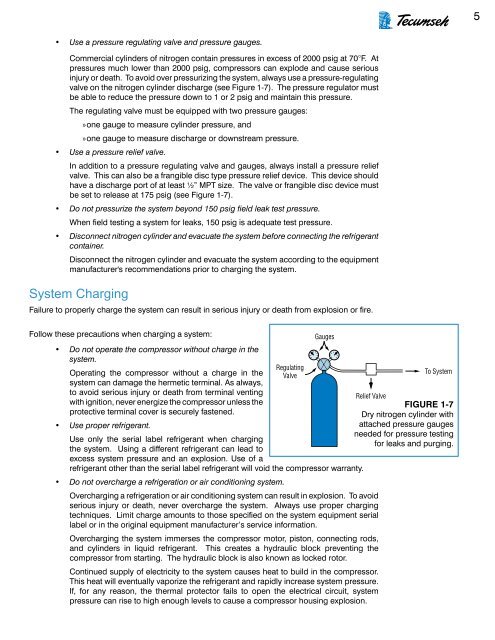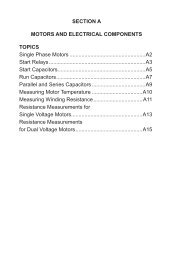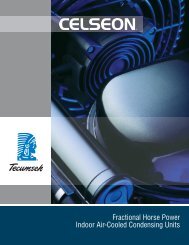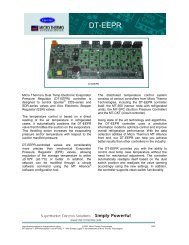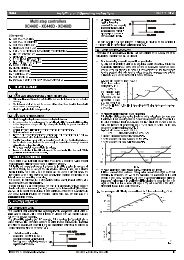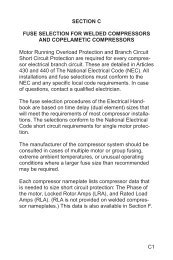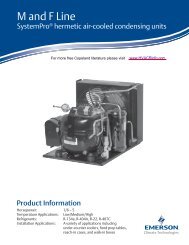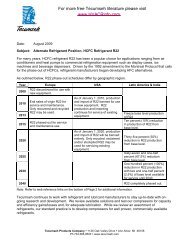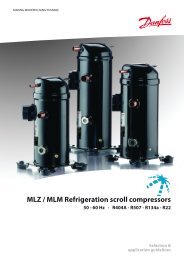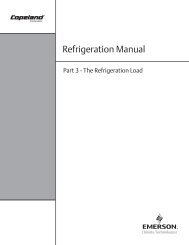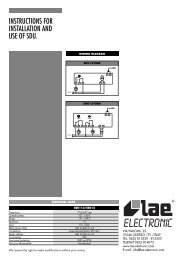Hermetic Compressor - Tecumseh
Hermetic Compressor - Tecumseh
Hermetic Compressor - Tecumseh
Create successful ePaper yourself
Turn your PDF publications into a flip-book with our unique Google optimized e-Paper software.
5<br />
• Use a pressure regulating valve and pressure gauges.<br />
Commercial cylinders of nitrogen contain pressures in excess of 2000 psig at 70°F. At<br />
pressures much lower than 2000 psig, compressors can explode and cause serious<br />
injury or death. To avoid over pressurizing the system, always use a pressure-regulating<br />
valve on the nitrogen cylinder discharge (see Figure 1-7). The pressure regulator must<br />
be able to reduce the pressure down to 1 or 2 psig and maintain this pressure.<br />
The regulating valve must be equipped with two pressure gauges:<br />
»one » gauge to measure cylinder pressure, and<br />
»one » gauge to measure discharge or downstream pressure.<br />
• Use a pressure relief valve.<br />
In addition to a pressure regulating valve and gauges, always install a pressure relief<br />
valve. This can also be a frangible disc type pressure relief device. This device should<br />
have a discharge port of at least ½” MPT size. The valve or frangible disc device must<br />
be set to release at 175 psig (see Figure 1-7).<br />
• Do not pressurize the system beyond 150 psig field leak test pressure.<br />
When field testing a system for leaks, 150 psig is adequate test pressure.<br />
• Disconnect nitrogen cylinder and evacuate the system before connecting the refrigerant<br />
container.<br />
Disconnect the nitrogen cylinder and evacuate the system according to the equipment<br />
manufacturer's recommendations prior to charging the system.<br />
System Charging<br />
Failure to properly charge the system can result in serious injury or death from explosion or fire.<br />
Follow these precautions when charging a system:<br />
• Do not operate the compressor without charge in the<br />
system.<br />
Operating the compressor without a charge in the<br />
system can damage the hermetic terminal. As always,<br />
to avoid serious injury or death from terminal venting<br />
with ignition, never energize the compressor unless the<br />
protective terminal cover is securely fastened.<br />
• Use proper refrigerant.<br />
Regulating<br />
Valve<br />
Gauges<br />
Use only the serial label refrigerant when charging<br />
the system. Using a different refrigerant can lead to<br />
excess system pressure and an explosion. Use of a<br />
refrigerant other than the serial label refrigerant will void the compressor warranty.<br />
• Do not overcharge a refrigeration or air conditioning system.<br />
Overcharging a refrigeration or air conditioning system can result in explosion. To avoid<br />
serious injury or death, never overcharge the system. Always use proper charging<br />
techniques. Limit charge amounts to those specified on the system equipment serial<br />
label or in the original equipment manufacturer’s service information.<br />
Overcharging the system immerses the compressor motor, piston, connecting rods,<br />
and cylinders in liquid refrigerant. This creates a hydraulic block preventing the<br />
compressor from starting. The hydraulic block is also known as locked rotor.<br />
Continued supply of electricity to the system causes heat to build in the compressor.<br />
This heat will eventually vaporize the refrigerant and rapidly increase system pressure.<br />
If, for any reason, the thermal protector fails to open the electrical circuit, system<br />
pressure can rise to high enough levels to cause a compressor housing explosion.<br />
To System<br />
Relief Valve<br />
FIGURE 1-7<br />
Dry nitrogen cylinder with<br />
attached pressure gauges<br />
needed for pressure testing<br />
for leaks and purging.


